What is Facial Contouring?
Facial contouring surgery modifies the shape, width, and ratio of the face by adjusting
the face's bony structure. It can also correct asymmetry and facial disharmony without bite adjustment.
Facial contouring surgery includes cheekbone reduction, square jaw reduction and genioplasty.
Depending on the patient’s facial features, and conditions, Facial liposuction,
facelift, and sunken cheek correction are the procedures that may be recommended with facial contouring surgery to create a synergistic effect.
They are skilled and experienced doctor with good reputation in Korea.
Summary of the Genioplasty
-

Operation time
Around 40~50 minutes
-

Admission
1 day admission
-

No. of visits
2-3 visits
-

Anesthesia
General anesthesia
-

Suture removal
10th~14thday
-

Recovery time (period of stay)
7~14 days
What is Genioplasty?
If the length and shape of the chin are imbalanced, it can create an unappealing appearance for the overall face.
A long or protruding chin can make you appear older and more aggressive, while a short or small chin can create a dull and immature appearance. Additionally, an asymmetric chin can cause the face to look crooked and unbalanced.
Genioplasty is a surgical procedure that corrects the length, width, and protrusion of the chin, whether it is receding or protruding. It can also refine asymmetry and improve the overall shape.
At Braun Plastic Surgery Clinic, the V-line chin shape can be achieved more naturally and effectively without the use of silicone implants. By utilizing an inverted V-shaped osteotomy, we can address the shortcomings of the traditional T-shaped osteotomy used in genioplasty.
Genioplasty is often combined with square jaw resection and lateral cortical bone shaving to create a natural and refined jawline.
Surgical Procedure
Incision Site
The procedure is performed through an incision inside the mouth, leaving no visible scars.
Surgical Method
1. Traditional Ineffective Methods | T-shaped Osteotomy
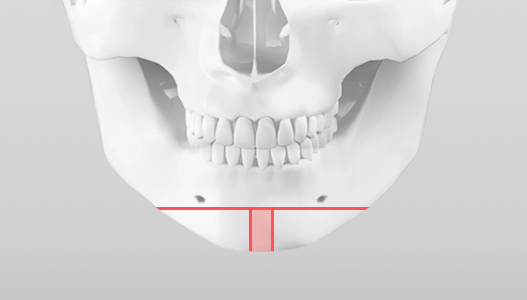
This surgical method involves cutting the bone into a T-shape and securing the bone pieces. The traditional technique of cutting the chin bone into a
T-shape does not allow for proper chin length adjustment, often resulting in a chin that appears too wide and U-shaped."
Additionally, because the osteotomy line is close to the nerves and tooth roots, there is a high risk of nerve or tooth damage.
2. Braun’s genioplasty method | Inverted V-shaped osteotomy
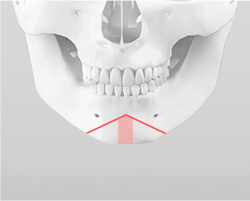
Excise the chin bone through an inverted V-shaped osteotomy
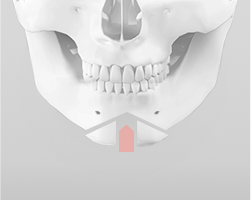
The removal of the middle chin bone segment allows for precise control over the length of the chin, based on the shape of the bone cut.
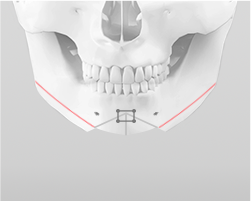
The excised chin bone segments are then gathered and secured with a titanium plate and screws. At this stage, the chin can be moved forward or backward.
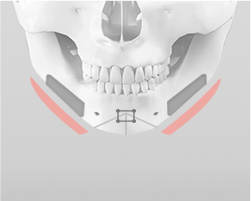
Performing square jaw resection and lateral cortical bone shaving
Recovery Process
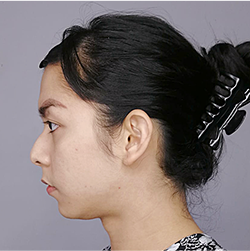
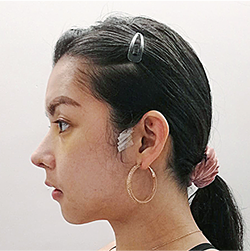
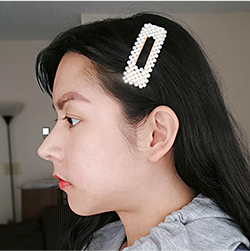
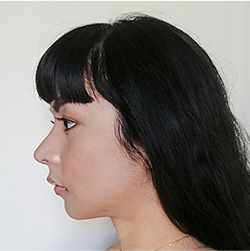
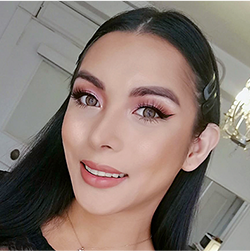
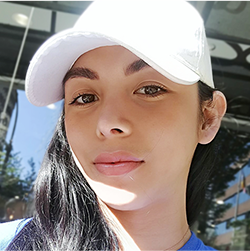


What is the Inverted V-shaped Osteotomy Invented by Dr. Kim Tae-gyu of Braun Plastic Surgery?
The traditional T-shaped osteotomy does not allow for proper chin length adjustment,
often resulting in a chin that appears too wide and U-shaped. Additionally, because the osteotomy line is close to the nerves and tooth roots, there is a high risk of nerve or dental damage.
After years of research and surgical experience, Dr. Kim Tae-Gyu, Chief Surgeon at Braun Plastic Surgery, developed his own technique in 2009.
This method addresses and improves upon the disadvantages and limitations of the conventional T-shaped osteotomy.
By adjusting the length of the chin, the inverted V-shaped osteotomy allows for either lengthening or shortening of the chin.
It effectively corrects both protruding and receding chins without the need for implants. This technique can also create a smooth V-line,
regardless of whether the chin is asymmetrical or wide.
Additionally, because the osteotomy area is positioned away from the nerves and tooth roots, the procedure can be performed safely with minimal risk of nerve or dental damage.
Dr. Kim Tae-Gyu published a thesis on his inverted V-shaped osteotomy in the prestigious international journal
“The Journal of Plastic and Reconstructive Surgery (PRS)”. His work has been recognized at both domestic and international plastic surgery conferences, earning him several academic awards.
Different surgery methods according to the shape of the chin
Long chin
The chin can be shortened through an inverted V-shaped osteotomy. The average length of the chin is ranges from 3 cm to 3.5 cm, and the length of the chin can be reduced by 2mm to 10mm by performing an inverted V-shaped osteotomy. Usually the long chin protrudes forward, and in this case, the length of the chin is simultaneously shortened and pushed backward.
Short chin
The chin can be lengthened by 2 mm to 6 mm using a modified inverted V-shaped osteotomy, without the need for bone grafts or chin implants. In most cases, a short chin is also positioned backward; in such instances, the chin can be lengthened and advanced forward at the same time.
Receding chin
The receding chin is moved forward by 2mm to 10mm without the use of bone grafting or chin implants through an inverted V-shaped osteotomy.
Protruding chin
The protruding chin is pushed backward by 2mm to 8mm through an inverted V-shaped osteotomy.
Asymmetrical chin
In many cases, the chin is noticeably curved to one side, or the lengths of both sides are uneven. Asymmetry can be corrected through an inverted V-shaped osteotomy by repositioning the chin to one side or by shaping the bone differently on each side. This procedure can improve chin asymmetry by approximately 60% to 90%.
Wide chin
The width of the chin can be adjusted during the inverted V-shaped osteotomy by cutting the middle of chin bone in various ways ranging from 2mm to 10 mm.
Candidates for Genioplasty
-
 If you have a long or short chin
If you have a long or short chin
-
 If you have a receding or protruding chin
If you have a receding or protruding chin
-
 If you have severe chin asymmetry
If you have severe chin asymmetry
-
 If you have a wide chin
If you have a wide chin
-
 If you want a refined and soft impression
If you want a refined and soft impression
-
 If you want a small, slim V-shaped chin
If you want a small, slim V-shaped chin
BEFORE & AFTER PHOTOS
FAQ
-No. At Braun plastic surgery, we perform surgery using only the chin bone and no other implants.
Because facial contouring surgery has nothing to do with orthodontic treatment, the procedure can be performed while wearing braces. However, because it is uncomfortable to open the mouth immediately after surgery, receiving orthodontic treatment may be difficult for the next 2/3 months.
-Yes. A light meal can be consumed approximately 6 hours after surgery. However, it is advised to consume foods with a soft, non-straining texture, such as porridge, tofu, and bread. For the first 10 days after surgery, it is best to avoid spicy, salty, or irritating foods, as well as hard or chewy foods that put strain on the jaw and surgical area.
- Yes, combining it with square jaw surgery or cheekbone surgery can improve your results.
However, because each patient is different, it is recommended to make a decision after consulting with a specialist.
-It will be possible to board a plane 5 to 7 days after surgery.
All surgeries carry the risk of swelling, scarring, infection, and bleeding. This may differ depending on the patient's physical condition and post-surgery care. However, if the surgery is decided after extensive consultation with an experienced specialist, the risk of side effects is greatly reduced.
Titanium pins, which are harmless to the human body and do not corrode, do not cause significant damage even if they remain in the human body for a long time, but if necessary, they can be removed from 1 year after surgery, and if you want to remove them, it is recommended to remove them quickly after 1 year. In some cases, it may be difficult to remove after a long period of time has passed.
- Since the stitches in the mouth are removed 10 to 11 days after surgery, it is recommended that you stay for about 2 weeks, but if possible, you can depart after a week if you can have the stitches removed in your home country.
- After about a week of recovery, you should be able to resume your normal activities.
- Though it varies from patient to patient, there is no visible scarring because the incision is made through the mouth.
We recommend that you avoid chewy foods and extreme sports for two months.
All of Brauns facial contouring surgeries are performed by Chief Dr. Kim Tae-Gyu Dr. Kim Tae-Gyu developed and received a patent for Braun's signature surgical techniques, the inverted v-shaped osteotomy and the 3D lifting cheekbone surgery, which are more effective and safer.

Publication in World-Renowned Plastic Surgery Journal
-
2019 PRS KOREA 2019 Korean Plastic Surgery International Conference
Chief Director Kim Tae-gyupresented on the subject of "Buccal depression in the Reduction Malarplasty" during the ‘Facial Contour’ session.
-
2019 PRS KOREA 2019 Korean Plastic Surgery International Conference
Presentation by Chief Dr. Kim Tae-gyu at the Craniofacial Session 8 on "The Clinical Study of Lateral Fixation in Reduction Malarplasty."
-
2017 Korean Society of Aesthetic Plastic Surgery APS (Aesthetic Plastic Surgery) International Conference
Free topic presentation on "Concurrent operation of facial contouring and lifting surgery" by Chief Dr. Kim Tae-gyu.
-
2016 Korean Society of Aesthetic Plastic Surgery APS (Aesthetic Plastic Surgery) International Conference
Presentation on "Cheek bone Revision Surgery Using Cheekbone Resection" and "Chin Tip Revision Surgery Using inverted V-shapeosteotomy." by Kim Tae-gyu, Chief Doctor of the Facial Contouring Department.
-
2016 JCS (Journal of Craniofacial Surgery)
Chief Dr. KimTae-gyupresenting his research thesis on "Lifting 3D Cheekbone Rotation Surgery."
-
2015 Korean Society of Aesthetic Plastic Surgery PRS KOREA 2015 Tradition and Innovation
Presentation by Kim Tae-gyu, Chief Doctor of the Facial Contouring Department, “Cheek revision surgery using zygomatic bone resection”, “Chin osteotomy and chin revision surgery using inverted V-shape osteotomy.”
-
2013-2015 Plastic and Reconstructive Surgery Global Open
Chief Dr. Kim Taegyu, published a research paper on "V-line jaw surgery using inverted V-shape osteotomy (reverse V-line)"

2019 Korean Plastic Surgery International Conference

2018 Korean Plastic Surgery International Conference

2017 Korean Society of Aesthetic Plastic Surgery APS (Aesthetic Plastic Surgery) International Conference

2016 Korean Society of Aesthetic Plastic Surgery APS (Aesthetic Plastic Surgery) International Conference

2015 Korean Society of Aesthetic Plastic Surgery PRS KOREA 2015 Tradition and Innovation
REGISTERED TRADEMARK IN FACIAL CONTOURING
Obtained service mark from the Korean intellectual Property Office Inverted V-shape osteotomy developed by Chief Dr. Tae-gyu Kim
-

Service slip registration certificate
-

G osteotomy
-

Deep cheekbones
-

Deep ball square jaw
-

Contour of the face of the deep cheek
-

Square jaw surgery on the corner of the mouth
-

Reduction of the corner of the mouth










































